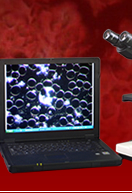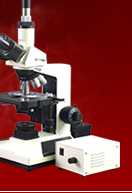
Plant Leaves Under the Microscope
Biologists rely on the microscope to help them look at things too small to be seen with the naked eye. Some organisms like bacteria can only be studied under the microscope, as Anton van Leeuwenhoek had found out. Leeuwenhoek is the first person to study microorganisms, and he is given the title “Father of Microscopy” for this. Studies on bacteria had resulted in so many useful things like the development of the pasteurization process, advances in tissue cell culture, molecular biology, microbiology and even some medicines.Looking at living organisms under the compound light microscope is quite an interesting science activity for students especially if there is some movement to be observed. This might make you think that it’s more fun to look at small animals than plants under the microscope, but there is a lot of microscopic movement in plants as well. You might not be able to see them with your naked eye, but there are veins in plants that carry nutrients that it gets from the roots to its other parts. This process can be likened to the way human blood circulates around our body.
The water that the roots of a plant get from the soil goes out to the leaves. If you take a thin sample from the underside of a leaf, you could look it under a low power objective and see small circular openings that are called stomata. A stoma (which means mouth in Greek), which is the singular of stomata, is surrounded by a ring of cells called guard cells. Guard cells can open or close up the stomata depending on the amount of water that the leaves need. For example, the stomata of old leaves may open up during the day and close down at night, but younger leaves need all the nutrients they can get to grow and may not open their stomata at all.
Do you notice the leaves of a plant turning over before or while it is raining? That’s because there is greater amount of water vapors before raining that stops the stomata from releasing gaseous water into the already saturated air. What the plant does to go around this is twist the leaves so that their undersides face up where the air currents are less saturated. That’s a great way to tell if it’s going to rain later on, isn’t it?
Sunlight has an effect on stomata, too. There are substances in the microscopic guard cells that turn the starch in them into sugar. This sugar makes the guard cells swollen, enlarging the opening of the stomata as can be seen through the student microscope. You could see how this works by doing an experiment on the leaves of some plants. Wandering Jew, plantain or Boston fern are plants with large stomata and they would be ideal for this science microscope activity. All of these are easy enough to find since they are commonly raised as house plants.
Take a leaf from either of these plants and roll it a bit in your hands to loosen the outer skin a bit. Then scrape a sample off the epidermis (skin) from the underside. You need to use a razor to do this, so make sure to ask help from an adult. Once you’ve got your samples (make at least two), mount them on separate blank microscope slide using the wet mount method. You might want to check them under the low power objective lens first to see if the sample you have taken have stomata in them. If they do, put one of your slides in a dark, wet place (for example, a glass of water placed in the back of a closet) and put the other microscope slide where it can catch some sunlight. Make sure that the latter keeps moist. If the water in the slide dries up, just put a drop of water near the side of the slide cover that still looks wet.
Wait for about an hour before looking at the samples under the low power objective lens of the compound light microscope again. Do you see the difference between them?
Botany is the side of biology that focuses on the plant kingdom and the compound and stereo microscopes are crucial in helping botanists see how the structure of plants makes them work. Think of the parts of a flower, as well, and how they are too small to be studied properly without looking at them under the students microscope. Scientists and students alike will find it beneficial to use light microscopy techniques in studing botany. For students, enlightening them to the plant world is exciting and challenging for their minds.




